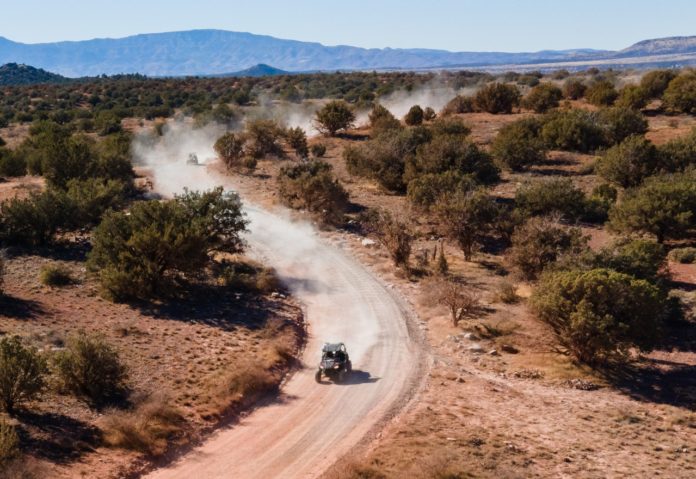
On Wednesday, Oct. 9, the Sedona Chamber of Commerce unveiled the first fruits of talks it convened this summer with off-highway vehicle businesses and Coconino National Forest officials to develop plans to mitigate impacts from OHV recreation west of Sedona.
In July, Forest Supervisor Laura Jo West had floated the possibility of road closures if progress wasn’t made.
In Wednesday’s release, the chamber announced the formation of the Red Rock OHV Conservation Crew, a coalition of local ATV and Jeep rental businesses, along with Tread Lightly!, an OHV industry group that promotes ethical motorized recreation.
According to the release, business members — more than a dozen companies whose customers use Coconino National Forest roads and trails — have pledged to contribute 1% of sales to the forest for land preservation and rider education. Members of the coalition who are currently USFS permittees will pay the 1% in addition to the 3% they already pay the forest under the terms of their permits. The chamber estimated that these new contributions could net USFS as much as $400,000 annually.
The release stated that the group began collecting funds in September.
The second prong of the RROCC — rider education — is less concrete than the funding component. The chamber said that RROCC would work with Tread Lightly! to “produce educational content on public safety, limiting speed, noise and dust, respecting others who use the roads, observing sensitive areas such as the grasslands west of Sedona and leaving historical or archeological sites undisturbed.”
The release also noted that an “official USFS OHV Ambassador Program” staffed by local OHV companies would interact with riders on Forest Road 525 during the Monday holiday on Oct. 11, when use is expected to be high.
The voluntary 1% contribution by Jeep and ATV rental companies will provide a way for rental companies that aren’t permitted by USFS to contribute badly needed funds to resource protection. Coconino National Forest leaders have consistently said that current resources are stretched thin to manage the level of recreation the forest receives.
As the Sedona Red Rock News reported in the spring, the Red Rock Ranger District has funding for two law enforcement officers, who are authorized to enforce traffic rules, covering an area two-thirds the size of Yosemite National Park.
Because of the way USFS defines outfitting and guiding, only tour companies that physically accompany guests onto forest land need to apply for permits and pay the 3% guiding fee to the forest. These permit fees go to enhancing and protecting resources — like roads — used by permittees.
In recent years, self-guided tours using rented side-by-sides and Jeeps on Sedona-area forest roads have grown in popularity. OHV owners bringing their own vehicles to the road system has also increased.
Renters receive detailed directions to a handful of routes close to town, but because the customers are driving themselves, the activity is not regulated under the outfitter/guide permit system. In this situation, as OHV rentals grew in popularity, USFS recreation funds remained flat.
On the newly announced measures, Becki Ross, operator of the Windmill Mountain Ranch off Forest Road 525, said this week that “for the sake of the rangeland and quiet neighborhood roads that have been changed, I hope and pray that it’s successful. I appreciate the effort that many good businesses and folks are putting into this pilot program, but like many of my neighbors, I am certainly frustrated with the whole situation.”
Ross and DeAnna Bindley, a member of Save Bear Mountain, a group of residents raising the alarm over OHV recreation, said this week they’d wanted to be more involved with the chamber’s talks.
“As the USFS grazing allotment owners for over four decades, we asked to be a part of this group. We would like to be a voice for the range health and protect our ranch improvements such as water troughs, waterlines, fences and stock tanks, and are hopeful that we can be a part of the conversation,” Ross said.
She added that recent interactions with the chamber have left her feeling like it is “not very open to what we, the residents, have to say …. I am afraid they’re going to make their own decisions on what to do without any input from the community.”


















